Melbourne – Australia’s Second City
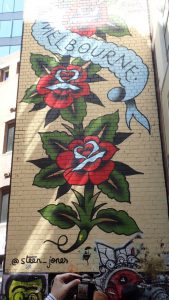
Melbourne is Australia’s second largest city and reminded us a lot of Chicago. The city is bustling with high rises buildings, large sport venues, major museums and cultural institutions, prominent theaters and numerous universities. The location is along Port Phillip Bay and even has a repurposed dockland with a large Ferris wheel. As an international gateway, the city is very diverse and a foodie heaven. We saw restaurants of every sort and lots and lots of bars and coffee shops. Every downtown street was lined with them.
But what’s really unique about Melbourne is its laneways. Many of the alleys between buildings that originally may have been used for deliveries or rubbish or even for sewage drainage 100+ years ago have been built out with shops, bars, and restaurants. Seating is either open air or under awnings with the kitchen or serving counter built into the adjacent building. Some are just carry-out places and some have indoor seating too. Rooftop and basement bars are also accessed from these laneways and are essentially hidden unless you know where to find them. So, how does one find them? You take a walking tour called the Hidden Laneways Bar Tour. ?
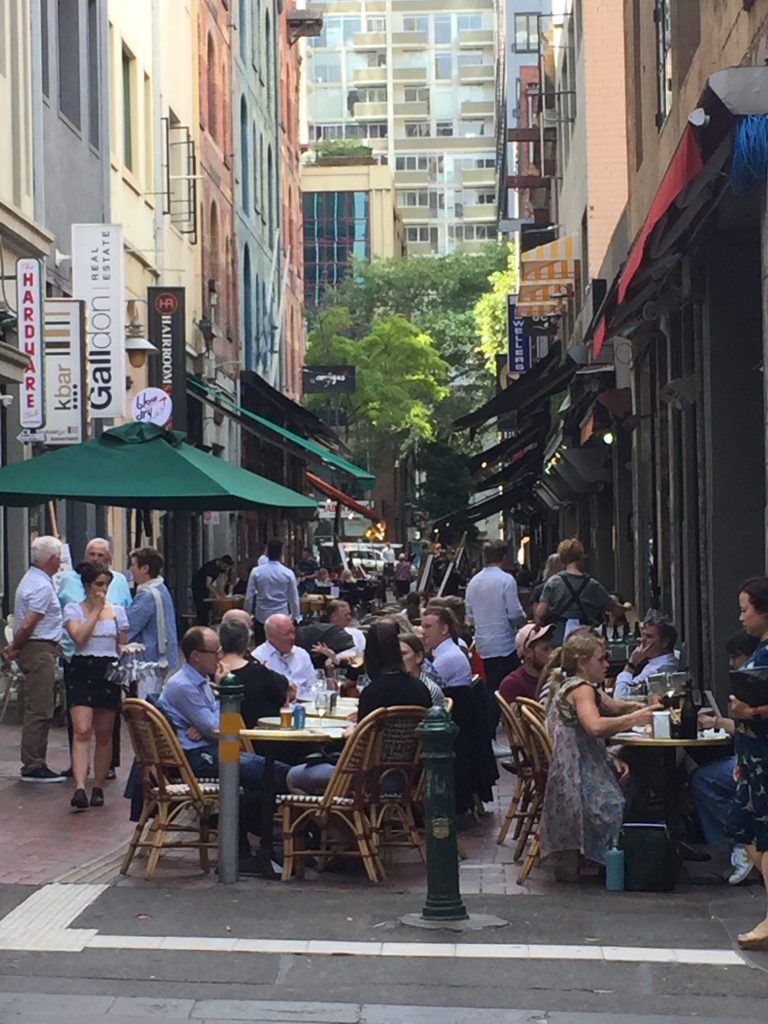
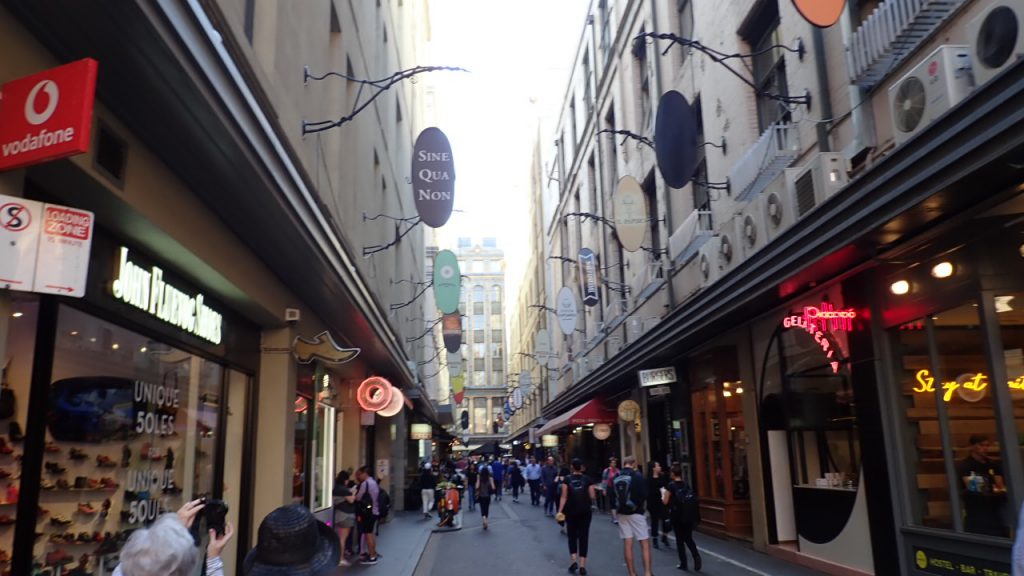
Since we had nine days in Melbourne, we tried to settle into a less touristy mode. We caught up on our network TV shows, did laundry, and started assembling our tax documents (boring, yes). We watched the latest political coverage at home, which has been quite interesting. In addition, word of the rapidly growing number of cases of coronavirus dominated the news. The travel bans are devastating to Australia’s tourism industry. We read that of the 9.4 million visitors in 2019, 7.6 million were from China. Couple this with the bush fires and we can only imagine the impact to Australia’s economy. One of our waiters estimated a 40% drop in business. Lots of Asians in Melbourne were wearing facemasks. Presently, we do not expect to alter our future plans (which did not include China or Hong Kong), but we’ll see.
Rather than packing in attractions from morning into night and eating out every meal, we enjoyed more of a leisurely pace and some homecooked meals. We even tried to go on the wagon for a bit. Well, that didn’t work so well.
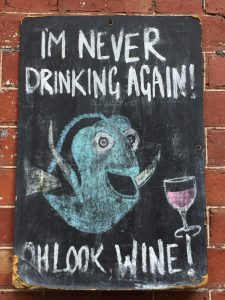
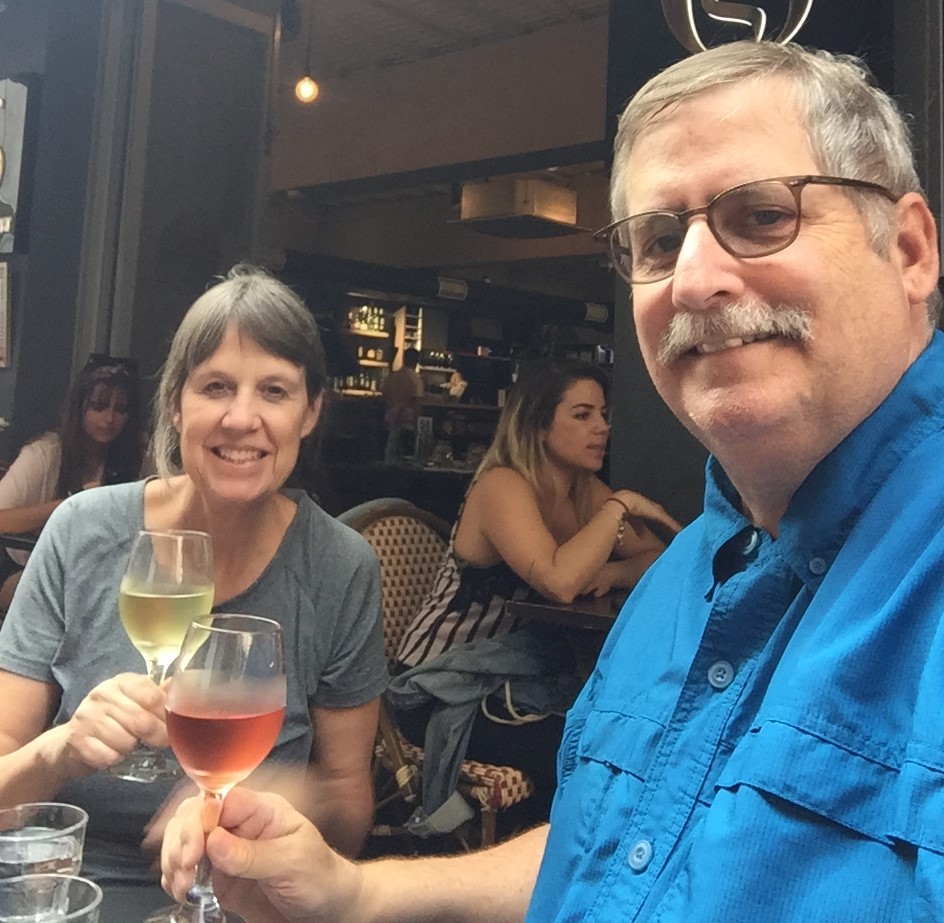
Actually, we did pace ourselves, other than during the aforementioned Hidden Bars tour. In our defense, per Steve’s iPhone step counter, we also logged 302,890 steps (103.6 miles) since we left Milwaukee, so we are getting our exercise. And we loaded up on fresh foods at the Queen Victoria Market, which was located about a block from our place, and is the largest open air market in the southern hemisphere. The markets has hundreds of vendor spaces with everything from bakery, cheese, meat, seafood, fruits and vegetables and clothing. As it gets closer to closing time, the vendors start calling out their prices and discounting the more ripe items. On Wednesday nights during the summer months, there is a Night Market with dozens of stalls with prepared food of every sort and live entertainment. It was clearly very popular.
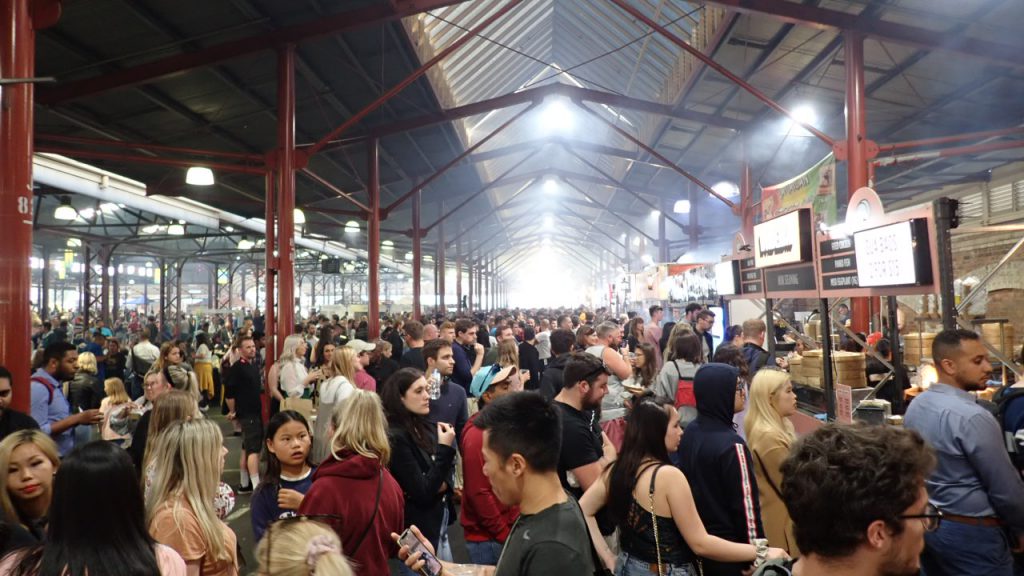
We were lucky to be in town for two Wednesdays and had tasty and very economical meals both nights. And these were not your typical potatoes-
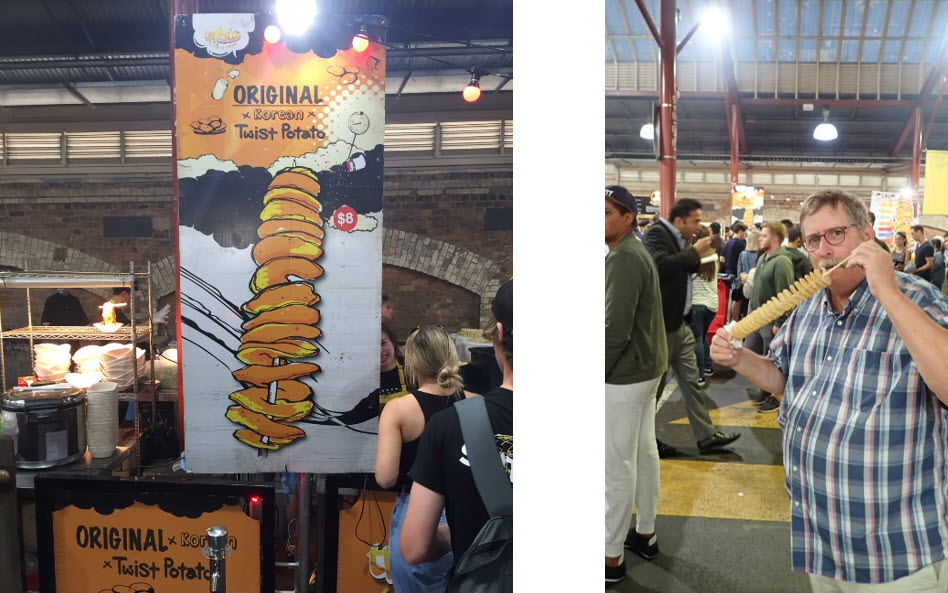
Oh, and the $8 on the sign is in Australian dollars, so about $5.35 in USD for a yummy potato. Actually, we should mention that we are grooving on the strong U.S. dollar. In addition to the favorable exchange rate, most things have been less expensive than we had originally anticipated. This has allowed us to splurge on some things, but still stay somewhat on budget.
Melbourne has an extensive tram system, which is free to use within most of the CBD. Our rental was within the free zone and one block from a tram stop so we used it frequently. Since they are free to ride, the trams were usually packed. The tram system is what The Hop streetcar in Milwaukee aspires to be (but never will, in our humble opinion). Melbourne has a much larger population and significantly higher density in the central city. The tram lines are part of a much larger system that go well beyond downtown, also in densely developed areas. Outside of the free zone, the tram costs $3.00 USD per ride, which would never fly in Milwaukee. Enough about that. Managing the coexistence of the tram and automobiles necessitated some pretty interesting traffic patterns. We saw the following signs all over and watched the dance as right turning cars would slide over to the left before making the turn.
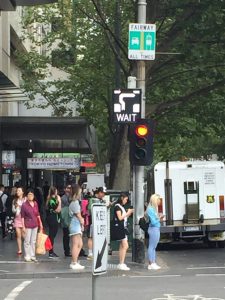
Our new friend, Gary, explained that the cars need to move to the left to let the cars behind them and the trams continue through the intersection while the light is green. Once the light turns red, they can proceed through the turn. Generally, it seemed to work well. When watching this process, we were so happy that we did not have a car.
We did some touristy things. We took a walking tour and learned about the history of the region, which was largely settled as a result of the gold rush of the mid-1800s. During the 1850s, Melbourne had significant wealth. Elaborate buildings were built for government and cultural purposes. Many now house museums and other institutions. We toured the Immigration Museum, which fittingly is in the original Customs House. Australia has gone through phases where it needed population to work in agriculture or to support gold mining. Following WWI, Australia decided its population was too low to defend itself in a world conflict. There were other timeframes where the immigration doors were closed. Until the 1970s, the country was very picky about who could become citizens. Like many first world countries, the current stance on immigration is being debated as large populations attempt to find better lives for themselves and their families. Overall, the museum did a nice job of presenting the immigration story.
We toured the Old Treasury Museum, which was in the original treasury building and had our favorite price tag (free!). The basement had subterranean bunkers that housed the gold in the 1800s. The gold rush days were the equivalent of the U.S.’s wild west with rough riders, dance halls, saloons, etc. Interesting.
Our final tour was of the State Library of Victory. It’s way more than a library. The building houses historical artifacts and an art museum. The original building section dates to the mid-1800s and has recently been extensively renovated. Besides showing us around, the docent shared the history of the building as well as how areas function in today’s information age.
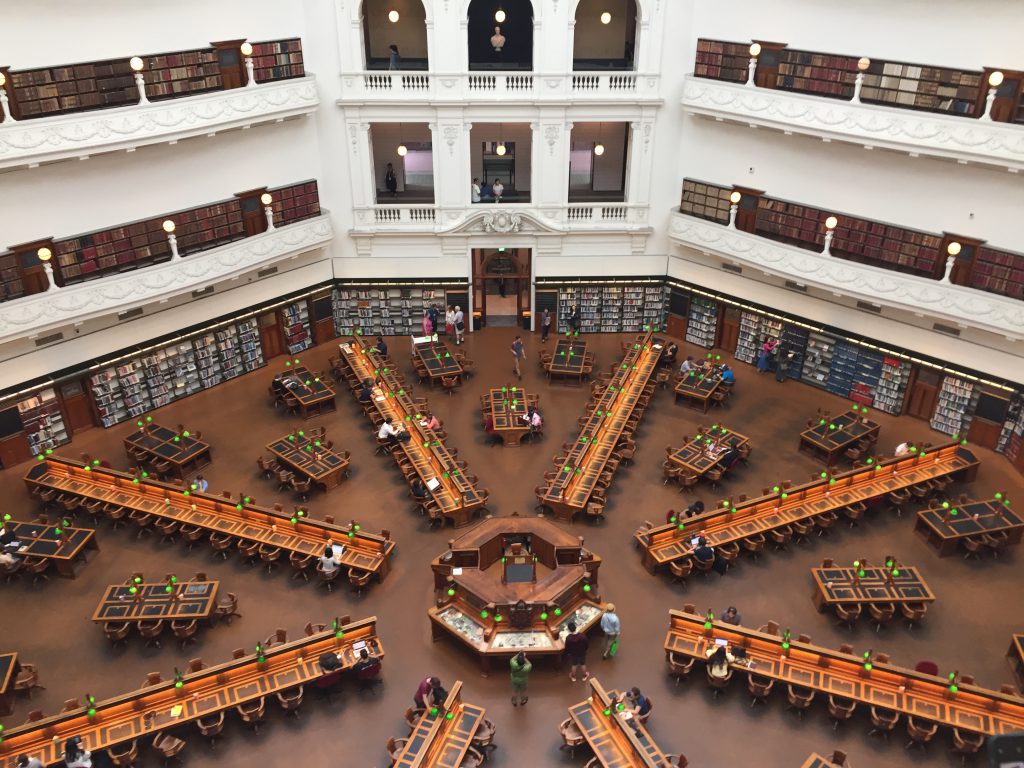
We enjoyed our stay in Melbourne. The weather was exceptional, the food was great and the sights were interesting.
6 Replies to “Melbourne – Australia’s Second City”
My, my, it sounds wonderful! So glad you had fun. Great write up, thanks!
Wow! What an amazing time! It is interesting that Australia also had the old west. All is good here. Snow and more snow, End of March we head to Tennessee where the flowers are already starting to bloom. Love your blog! The potato looked delicious!
Hi Lindquist’s
Sounds like an amazing trip. So glad none of these awful world events have changed your plans to this point . Thanks for taking the time to post about all of your travels. Stay safe and have fun!!!!!!!
Getting on wagons is for working people, not the retired. Live it up and do not consider such nonsense in the future.
Thank you, Bill. We will take your advice under consideration.
Melbourne has always been high on my wish list of cities to check out–looks awesome! Great combination of modern vitality & Victorian architecture. Funny that you had Korean potatoes in Australia–one of our favorite, must-eat foods at the Minnesota State Fair has been Australian Battered Potatoes! Have Fun!!